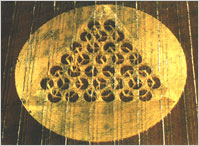 |  | 

By Rod Dickinson and John Lundberg
The seven of us entered the field at 11pm, with two journalists. A total of nine people. Deetkin's story only reinforces our conviction, that, with element of surprise on our side it is very, very easy to slip into a field and create a large formation without being detected. In Anatomy of Deception Silva maintains that it is hard to create patterns in the English countryside without being caught. He is wrong and not alone. Crop Circle researcher Michael Glickman also doubted our involvement in creating the formation. In the crop circle magazine the Sussex Circular (no86) he cited other witnesses who impressed upon him their presence in the locale, and who saw nothing. Also in the Sussex Circular (no89) Marcus Allen throws doubt on our claim to have made this formation.
Whilst Silva was not impressed with geometry on display in the Avebury Triangle, Glickman was (though he clearly doesn't believe it was our work) "If anyone had asked me, after ten years of study which was the cleverest crop formation in terms of number and geometry, I would have put Avebury in the top ten." Sussex Circular (no86).
 The diagrams published here are copies of the diagrams that each circlemaker took into the field. To construct the formation we only used an assortment of surveying tape measures, some premarked with specific dimensions, and seven stalk stompers to flatten the crop. The diagrams published here are copies of the diagrams that each circlemaker took into the field. To construct the formation we only used an assortment of surveying tape measures, some premarked with specific dimensions, and seven stalk stompers to flatten the crop.
The formation was designed on a cad system and constructed using a methodical construction sequence. We created the outer perimeter first, scribing a huge equilateral triangle within it (with sides of 260ft long.) Flattening a 4ft pathway around the triangle and perimeter to give us easy access to any point in the formation.
The area within the triangle was then marked and divided by an isometric grid which generated 36 hexagons. The isometric grid was created by stretching surveying tapes across points marked along the edge of each side of the triangle. The grid was flattened into the crop by a circlemaker sidestepping along the stretched tape, which once flattened over created a series of underlying paths. Meanwhile the vast area of crop between the edges of the triangle and the perimeter of the formation was flattened in a simple concentric pattern.
The last part of the procedure, the most difficult part, involved identifying each hexagon. Scribing a circle within it, tangential to each side of the hexagon. Two or three 4ft wide pathways were then flattened from the centre of the hexagon/circle to two or three points, or corners of the hexagon. This task had to be repeated 33 times, for 33 of the 36 hexagons. The last 3 hexagons on each point of the equilateral triangle were flattened into swirled centres.
These flattened pathways were strategically placed, and once completed gave the illusion of six cubes in isometric projection. We further arranged the flattened pathways so they would create the illusion of the familiar impossible Triangle discovered and drawn in 1934 by Swedish artist Oscar Reutersvärd.
As each circle was completed and the 4ft arms flattened into it the surrounding crop was flattened to leave the circle standing, isolated. At 4.30am with dawn breaking we left the field. Our work was done.
After a staying at the White Horse Hotel near Cherhill we returned at Midday to survey our handiwork. Apparently the formation had been found by researchers at 5.30am.
By midday it was crammed with circle tourists, a tv crew, and many crop circle researchers. The farmer Mr Farthing agreed to let people in the field for a small fee. An event which seems to have upset Silva, who apparently doesn't think the farmer should be recompensed for his loss of crop.
We were extremely happy to have made Mr Farthing a small goldmine for a few weeks. We are very grateful to him for allowing us to make the formation on his land. Unlike Silva we welcome farmers capitalising, on our work or our colleagues work.
Ultimately he believes our Avebury formation was "inferior work" and "without meaning". Once again he does everything to miss the point. This was an artwork that interrupted the flow of people through Avebury for several weeks, and in some cases added a new experience to some of their lives. The formation occupied the field adjacent to Avebury Rings as temporary celebration of that ritual landscape.
Conclusion
Silva, Glickman and Deetkin occupy a world view where they have shut down their belief in the imagination and ingenuity of human beings to create extraordinary artworks - like the formations that are displayed on this website. In their reductive world view of hoaxes and genuine crop formations they muster every irrational argument to refute and deny the capacity and power of the human imagination. We circlemakers are happy not to share their darkness.
Postscript
Silva's lack of generosity also extends to us, The Circlemakers personally, whom he compares to a terrorist organisation - and whilst he has replied on his website to the first part of this article, unlike us he has put no link back to this article. Preferring for his viewers to read our comments out of context. Perhaps he should remove the free speech blue ribbon prominently displayed on the front page of his website....
[ Page 3 of 3 ]
|  |  |













